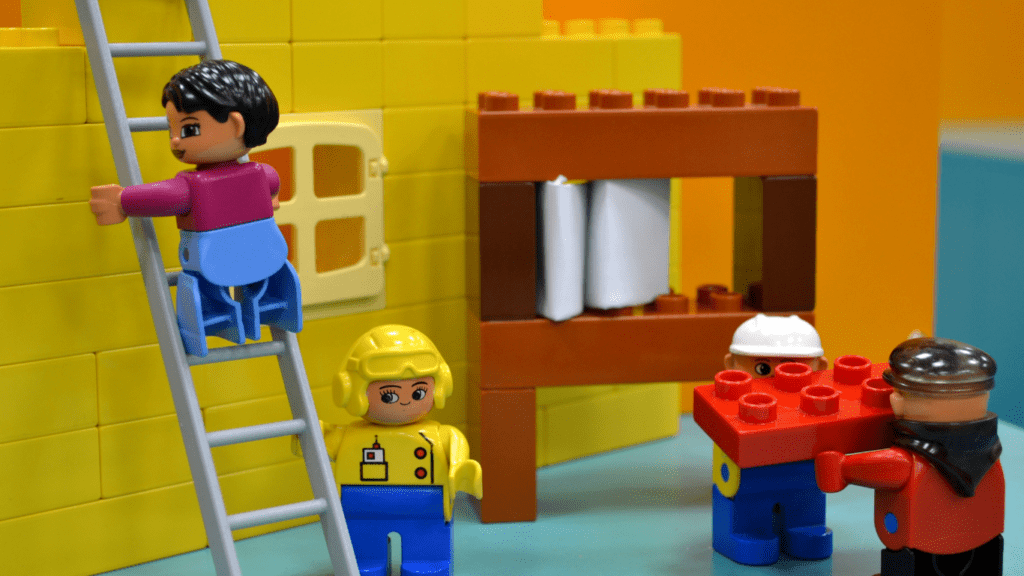The Evolution of Lego Games
Lego games have undergone significant transformation since their inception, evolving from simple block-building to complex digital experiences.
From Bricks to Pixels: The Journey
The journey started in the late 1990s when Lego first ventured into the digital realm.
- Lego Island (1997): Paved the way, offering an open-world experience where players could explore, interact, and build.
As technology advanced, the games became more sophisticated.
- Lego Star Wars: The Video Game (2005) marked a pivotal moment by blending iconic movie storylines with Lego’s unique humor.
These games evolved from basic interactions into intricate narratives where every brick had a story, bringing characters to life with engaging plots and memorable dialogues.
Innovations in Gameplay and Design
Innovations in gameplay and design have been central to the success of Lego games. Early titles focused on simple construction and exploration.
However, newer releases like Lego Dimensions (2015) introduced a hybrid experience, merging physical Lego sets with digital gameplay. Developers have integrated multiplayer formats, allowing cooperative play, enhancing social interaction.
Design improvements, such as enhanced graphics and more intuitive controls, have further enriched the gaming experience.
These innovations ensure that each new title not only entertains but also teaches creative problem-solving, maintaining Lego’s foundational emphasis on imagination.
Storytelling in Lego Games
Lego games don’t just offer gameplay; they tell compelling stories. These narratives engage players, turning simple brick-building into immersive adventures.
Crafting Narratives in a Blocky Universe
Game developers create rich plots in Lego games. By combining humor, action, and familiar characters, they weave stories that captivate all ages.
Players find themselves in detailed worlds, solving puzzles and completing quests. For example, in Lego City Undercover, the storyline follows Chase McCain as he battles criminals using disguise and wit.
Iconic Lego Game Storylines
Several Lego games feature memorable storylines such as:
- Lego Star Wars: The Complete Saga adapts the entire Star Wars film franchise, allowing players to relive every iconic moment.
- Lego Batman, on the other hand, merges Gotham’s dark aesthetics with light-hearted plot elements.
Each game excels in integrating storytelling with engaging gameplay, making the experience unique and unforgettable.
Lego Characters and Their Development

Lego games have transformed static plastic figures into dynamic characters with distinct personalities. This evolution has greatly enriched the storytelling within the games.
Bringing Plastic Figures to Life with Personality
Developers inject life into Lego characters through detailed animations and expressive gestures. For example, characters in Lego Batman exhibit unique combat styles and humorous dialogue that enhance their personality traits.
These traits bridge the gap between the player’s imagination and the in-game representation, creating a more immersive experience. Voice acting adds another layer of depth, making characters more relatable and memorable.
Fan-Favorite Characters and Their Stories
Many Lego games feature well-known characters from popular franchises. In Lego Harry Potter, players relive iconic moments from the series through the eyes of their favorite wizards.
Meanwhile, Lego Marvel Super Heroes brings together a vast roster of Marvel characters, each with their own storyline and special abilities. These engaging narratives respect the source material while adding a playful Lego twist.
The combination of familiar characters and engaging stories makes these games resonate deeply with fans.
Interactive Elements in Lego Games
Interactive elements make Lego games more engaging than ever. They connect players with the story and characters.
How Interactivity Enhances Storytelling
Interactivity is key in Lego games, improving storytelling by involving players directly. When players control characters and navigate through environments, they become part of the narrative.
For example, in Lego Jurassic World, players can rebuild structures to solve puzzles, which seamlessly integrates gameplay with the unfolding story. This immersion keeps players invested, as their actions directly influence the plot’s progression.
Voice acting and animated expressions further enhance the experience, making characters feel alive.
Player Choices and Their Impact on the Narrative
- Player choices shape the narrative in Lego games, providing unique pathways and outcomes.
- This dynamic storytelling allows for multiple endings, adding replay value.
- In Lego City Undercover, players decide how to approach missions, influencing character interactions and storylines.
- These decisions help personalize the gaming experience.
- Choices can lead to hidden secrets or alternative story arcs, ensuring that no two playthroughs are the same.
- This level of control empowers players, making them active participants in the story rather than passive observers.

 is an experienced contributor at Play Briks Construction, where he specializes in exploring the educational potential of construction toys in early childhood development. His work emphasizes the importance of hands-on play in fostering creativity, problem-solving skills, and spatial awareness among children. Patrick is dedicated to providing parents and educators with practical insights and strategies for integrating construction play into learning environments. He also focuses on the latest trends and innovations in the toy industry, ensuring that his audience stays informed and engaged.
is an experienced contributor at Play Briks Construction, where he specializes in exploring the educational potential of construction toys in early childhood development. His work emphasizes the importance of hands-on play in fostering creativity, problem-solving skills, and spatial awareness among children. Patrick is dedicated to providing parents and educators with practical insights and strategies for integrating construction play into learning environments. He also focuses on the latest trends and innovations in the toy industry, ensuring that his audience stays informed and engaged.
